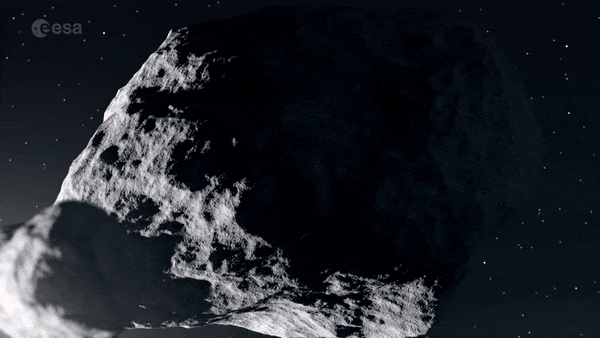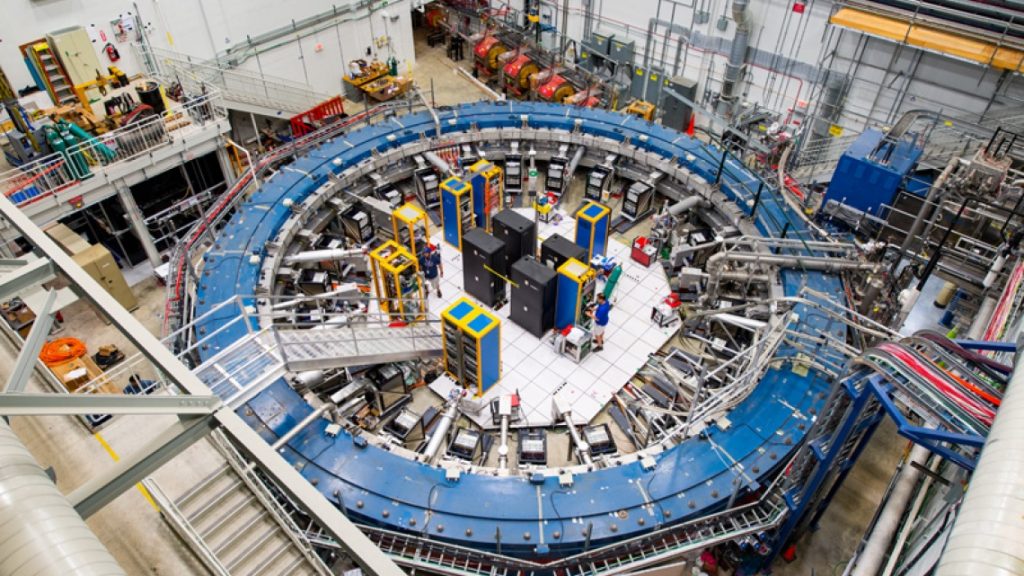Fermilab released the first results of their Muon g-2 experiment this week, and the fundamental particles don’t behave as predicted by the Standard Model of Particle Physics. Plus, dust, more dust, Martian water (again), and a review of Packing for Mars by Mary Roach.
Media
Transcript
Hello and welcome to the Daily Space. I am your host Beth Johnson, and I am here to put science in your brain.

Pamela is dealing with all of the noisy events happening at her house today, between leaf blowers and furniture delivery, and it’s all happening right when we normally record, so I’m flying solo. Later on, in the show, I’ll be joined by Annie Wilson for a brief discussion of our first book club selection, Packing for Mars by Mary Roach. But first the news.
Today’s news starts us off considering dust. We all see it build up in our house if we don’t dust enough, and really who has time for that? This is nothing compared to the outside world, however.

Growing up, it always mystified me that enough dust and dirt fell out of the air to somehow, over time, completely bury ancient civilizations. As an adult, I now know that plants are taking nutrients from the air and soil and converting them into structures fully capable of burying my flower beds in three inches of leaves. I know dust blown from deserts and ash exploded out of volcanoes can travel the world, layering grit on every surface in depths ranging from dustings to many inches. What I didn’t know, until today, was that 5,200 tons of space grit make it to the surface of our world every year. 5,200 tons.
We knew, based on the number of streaks seen across the sky, that our world is regularly hit by a lot of space rocks. To determine how much material actually strikes the planet, researcher Jean Duprat traveled to the Franco-Italian Concordia station in the heart of Antarctica and collected samples from the snow in a site where there would be a near absence of terrestrial dust. By assuming that what was collected in Antarctica is representative of what fell everywhere in the world, they were able to calculate the worldwide dustfall of dust from space.
The grains they found ranged from 30 to 200 micrometers, and it appears that 80% of the material comes from comets, with the remainder from asteroids. So now you know, when your car is filthy, you can blame air pollution, pollen, ash, dust, and space dust.
As much you, I, and most people may have a special dark place in our heart for the dust we are forever having to clean, dust in space is actually a really good thing. In a pair of new papers appearing in Science Advances, researchers have been able to track how carbon dust goes from the clouds of space to be an integral part of life on Earth.

According to researcher Marc Hirschmann, lead author of one of the two papers: Most models have the carbon and other life-essential materials such as water and nitrogen going from the nebula into primitive rocky bodies, and these are then delivered to growing planets such as Earth or Mars. But this skips a key step, in which the planetesimals lose much of their carbon before they accrete to the planets.
Put another way, we imagine these great clouds of material collapsing to form a star and its surrounding planets, and this is likely true, but we have to remember those forming planets and the stuff they form from is all baked by the young sun. Some materials, including carbon and water, get blasted off. To get to worlds like Earth, rich in carbon, the team assumed the carbon had to be locked away in the cores of these forming worlds – worlds like Earth – where it couldn’t be blown away. The lead author of the second paper, Jackie Li, puts it this way: We asked how much carbon could you stuff in the Earth’s core and still be consistent with all the constraints.
These studies found that worlds really need to start with a lot of carbon to get to keep enough carbon to eventually support life. Sure, meteors and comets that formed farther from the Sun will bring us some of the carbon we need, but it may be that to get a world with a carbon cycle that supports life, you really need to start with planet-forming objects that hide their carbon in their cores.
This work, and much of the work on this topic, is being done using computer models that make assumptions about the compositions of asteroids. We can see rocky surfaces, we can make assumptions about asteroid structures, but to really understand what they are made of we need to see inside. Luckily, some asteroids – like the often discussed Bennu – have been badly shattered often enough that their surface is a mix of rocks that once used to be on the inside.

The asteroid Didymos is thought to be another one of these rubble pile asteroids, and the European Space Agency is planning to send a pair of missions to this world to first try and move its moon and then to see the outcomes of that attempted push.
One of the confusing aspects about how Didymos is how it is held together. This is a tiny asteroid, and it is spinning around its axis every couple of hours. If Didymos is made of a bunch of boulders, it should have flung itself apart. Researchers, led by Yun Zhang, tried to figure out what could be gluing these boulders together by running a series of computer models to see if the electrostatic forces of dust could do the trick, and you know what? It turns out that if you cake it in enough dust, you can actually glue a pile of boulders into an asteroid.
Personally, I find the science in this paper pretty cool, but the press release we received totally hid the science from the title, focusing instead on who was the last author on the paper: Dr. Brian May. Known for his involvement in a little band called Queen, this researcher at the London Spectroscopic Company added in the creation of the 3D models the work used. It turns out, if you’re famous enough for something unrelated to your research, even a last author can find their way into a press release.
While much of the press is focused on Perseverance and its little helicopter, Ingenuity, NASA’s Mars Curiosity rover continues to study and explore the Martian surface. In a new study published in the journal Geology, a team of researchers has analyzed images from Curiosity’s ChemCam instrument. These images were taken with the telescopic imager, and they have an unprecedented resolution for the Martian rovers.

Curiosity is currently exploring Mount Sharp, the central sedimentary peak within Gale Crater, Curiosity’s home base, really, and an impact crater from early in our solar system’s history, about 3.5-3.8 billion years ago. Mount Sharp is about 5.5 kilometers high, and it preserves an early record of Martian history that geologists have been waiting to study for years.
With these new images, those geologists have finally had their chance, and what they found shows far more climate change than predicted. We’ve talked here before about how there was water on the surface of Mars, possibly even a small ocean, and then that water disappeared. Earlier studies discussed the possibility that the water had evaporated and escaped the atmosphere due to the lower gravity, while recent studies now show that the water is more likely trapped underground in minerals and even subsurface glacial deposits.
But what were the conditions that lead to the change in the state of the water? Did it all disappear at once or over time? This new paper examined the recent images and found amazing sedimentary structures, in detail, that lead the team to conclude that there were multiple transitions between a wet climate and a dry climate.
Per the press release: Moving up through the terrain, Curiosity observed that the types of bed change drastically. Lying above the lake-deposited clays that form the base of Mount Sharp, sandstone layers show structures indicating their formation from wind-formed dunes, suggesting long, dry climate episodes. Higher up still, thin alternating brittle and resistant beds are typical of river floodplain deposits, marking the return of wetter conditions.
A reminder that we are using a robot on another planet to analyze that planet’s geology down to the details in the layers of different types of rock. These kinds of details are the stuff of sedimentologists’ dreams, and I heard many professors and students gush over them in pictures and in the field during my geology coursework. And we are getting to see them and explain them and understand them on Mars.
The other neat thing about this study is that it uses ChemCam in a way I hadn’t heard about before. I didn’t know it had a telescopic camera. I’m most familiar with it being the instrument that vaporizes rock fragments with a laser beam and then analyzes the plasma to get the composition of the rock. That’s one of the ways we know that the rocks in this area are primarily mudstone and sandstone. Those two types of rock alone would be enough to say there was at least one wet period and one dry but to get in there and see the actual thin layers alternating… amazing stuff.
The plan now is for Curiosity to keep climbing the foothills of Mount Sharp and drill into the various beds to get an even closer look at the materials that make up these layers.
Any of you who have been watching this show for a while know that Pamela kind of adores the Standard Model of Particle Physics and is amused every time some complex theories theorized particle fails to be found. Researchers know the Standard Model is incomplete. While it was able to successfully predict a number of particles, including the top quark and the Higgs boson, it doesn’t actually explain why the physics we have has to be the way it is instead of being something totally different. It’s like Kepler’s theory of planetary motion; it could accurately predict planetary motion but didn’t explain why they did what they did. It took Newton’s theory of gravity to explain the why and Einstein’s relativity to fill in all the details before we could get a mostly complete theory. So, with the Standard Model, we have a base that doesn’t explain the whys but still seems to work. Or at least it did until this week.

An experiment at Fermi National Accelerator Laboratory to look at unstable particles called muons. Muons are in many ways similar to electrons but are 200 times bigger and tend to fall apart into smaller particles and energy over time. Muons are naturally produced when cosmic rays hit Earth’s atmosphere as well as in other events where high-energy particles crash into things that slow them abruptly. Particle accelerators like Fermi can produce muons in large numbers, and recent research to look at how these muons interact in magnetic fields discovered that they don’t exactly do what was predicted.
Just like magnets can affect the motions of electrons, they also can affect muons; these are super similar particles. The fact that we understand electrons so well is part of how we can make amazing electronics. Because muons are unstable, they are harder to study, and we’re still confirming they also do exactly as predicted. In fact, it appears that there is something hanging out, undetected, that is affecting muons’ behaviors. This could be new forces, new effects, or just some underlying feature of the universe. We don’t know.
What we do know is Fermilab wasn’t the only place to get these results. Fermilab’s experiment was actually a follow-up to a 2001 experiment at Brookhaven that had enough error in the measurements and was weird enough that it had to be replicated to be trusted. Fermilab and Brookhaven results are in agreement, and, now we know, muons are reacting to something we know nothing about.
This is super cool. This is like when observers realized Mercury’s orbit doesn’t exactly do what Newton or Kepler predicted. It was close, but not perfect, and the difference pointed us in the direction of what was needed and allowed Einstein to know he was on the right path with relativity. This result is one new thing that says which set of equations need modification and tell us what kind of results those modifications should match. This is new information. We had an incomplete theory; we haven’t succeeded in figuring out what’s missing on our own, and now we have data. Annoying, not-matching-prediction data, and that is awesome.
We really look forward to the day someone says, and this is what was missing.
Joining me now is Rocket Roundup host Annie Wilson, who is here to discuss the first pick of our new book club, Packing for Mars by Mary Roach.
[Book Review]
This has been the Daily Space.
Learn More
Where’s My Hoover? Over 5,000 Tons of Space Dust Fall to Earth Each Year
- CNRS press release
- “The micrometeorite flux at Dome C (Antarctica), monitoring the accretion of extraterrestrial dust on Earth,” J. Rojas et al., 2021 April 15, Earth and Planetary Science Letters
Examining the Interstellar Journey of Carbon
- University of Michigan press release
- “Earth’s carbon deficit caused by early loss through irreversible sublimation,” J. Li, 2021 April 2, Science Advances
Dust Bunny Asteroids and Queen Guitarist Dr. Brian May
- ESA press release
- “Creep stability of the DART/Hera mission target 65803 Didymos: II. The role of cohesion,” Yun Zhang et al., 2021 July 1, Icarus
Martian Climate Did Not Change From Wet to Dry All at Once
- CNRS press release
- GSA press release
- Los Alamos National Laboratory press release
- “Alternating wet and dry depositional environments recorded in the stratigraphy of Mount Sharp at Gale crater, Mars,” W. Rapin et al., 2021 April 8, Geology
Fermilab Muon Experiment Might Indicate New Physics at Work
- Fermilab press release
Credits
Written by Pamela Gay and Beth Johnson
Hosted by Beth Johnson
Audio and Video Editing by Ally Pelphrey
Content Editing by Beth Johnson
Intro and Outro music by Kevin MacLeod, https://incompetech.com/music/


 We record most shows live, on Twitch. Follow us today to get alerts when we go live.
We record most shows live, on Twitch. Follow us today to get alerts when we go live.